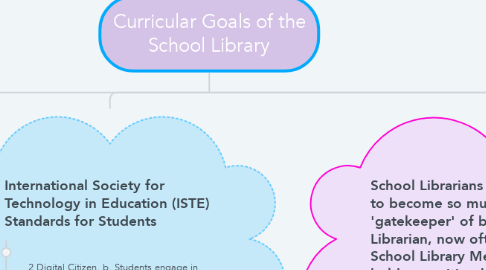Curricular Goals of the School Library
by Carly C.

1. Partnership for 21st Century Learning
1.1. • Enable innovative learning methods that integrate the use of supportive technologies, inquiry- and problem-based approaches and higher order thinking skills
1.2. • Use technology as a tool to research, organize, evaluate, and communicate information
1.3. • Learn from and working collaboratively with individuals representing diverse cultures, religions, and lifestyles in a spirit of mutual respect and open dialogue in personal, work, and community contexts
1.4. • Support professional learning communities that enable educators to collaborate, share best practices, and integrate 21st century skills into classroom practice
1.5. Use digital technologies (computers, PDAs, media players, GPS, etc.), communication/networking tools and social networks appropriately to access, manage, integrate, evaluate, and create information to successfully function in a knowledge economy
2. International Society for Technology in Education (ISTE) Standards for Students
2.1. 2 Digital Citizen, b. Students engage in positive, safe, legal and ethical behavior when using technology, including social interactions online or when using networked devices.
2.2. 3. Knowledge Constructor, b. Students evaluate the accuracy, perspective, credibility and relevance of information, media, data or other resources.
2.3. 7. Global Collaborator, b. Students use collaborative technologies to work with others, including peers, experts or community members, to examine issues and problems from multiple viewpoints.
3. School Librarians jobs have evolved to become so much more than the 'gatekeeper' of books. The School Librarian, now often called the School Library Media Specialist, holds a position highly integrated with technology and 21st century thinking. School Library curriculum should utilize technology such as computers, laptops, and tablets as learning tools for students. Technology allows students to collaborate using a multitude of programs, which allows them to display their learning process in a new and attractive way. Students must get accustomed to collaborating using technology in order to prepare them for college and eventually their careers. School Librarians must teach their students how to responsibly use the information they access. Not only do students need to learn how to analyze the credibility of sources, but also how to credit the reliable sources they use.
4. Sources:
4.1. Partnership for 21st Century Learning. (2019). Framework for 21st century learning. Retrieved from http://static.battelleforkids.org/documents/p21/P21_Framework_Brief.pdf International Society for Technology in Education (ISTE) Standards for Students. (2016). ISTE Standards for Students. ISTE. Retrieved February 21, 2020, from https://www.iste.org/standards/for-students


